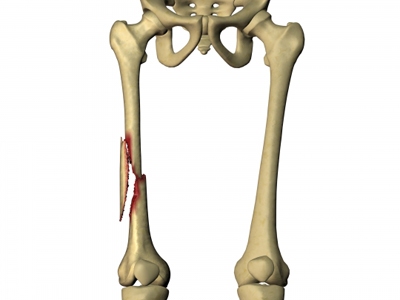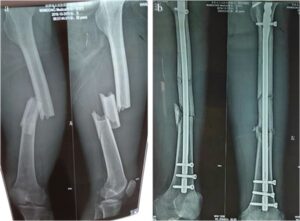A femur fracture can be a severe injury. If you or someone you know has suffered a femur fracture, it is essential to seek medical attention as soon as possible. We are here to discuss the various ways in which you can treat your femur fracture. Moreover, we will also provide some treatment guides for those who have suffered this type of injury.
Contents
What Is A Femur Fracture?
 When one of the bones in your thigh fractures or breaks, it can result in a devastating injury called a femur fracture. Depending on how severe the break is, this injury could need urgent medical attention and specialized care to heal correctly. There are several ways to treat this, these are:
When one of the bones in your thigh fractures or breaks, it can result in a devastating injury called a femur fracture. Depending on how severe the break is, this injury could need urgent medical attention and specialized care to heal correctly. There are several ways to treat this, these are:
- Medicine
- Physical therapy
- Surgery
Consult with a healthcare provider and carefully follow their suggestions to decide the best course of therapy for your femur fracture. Additionally, there are a few things you may do at home to hasten your recovery and lessen your pain and discomfort. It is possible to recover totally from a femur fracture and resume using your leg.
Causes Of Femur Fracture

Numerous events, such as falls, sports injuries, car accidents, and other traumas, can result in femur fractures.
The femur bone is located in the thigh area. The fracture of your femur can occur in a variety of accidents. Some common symptoms of femur fracture include pain, swelling, bruising around the site of the injury, and limited mobility in the affected leg.
Femur fractures can happen to anyone, however, the elderly are more at risk than others. People mistakenly believe that the words “hip fracture” and “femur fracture” are interchangeable. The position is what makes the difference. the injury’s proximity to the hip
Femur Fracture Treatment Options
There are several different treatment options available for femur fractures, depending on the severity of the injury. These may include:
- Non-surgical treatment
- Surgical treatment
It is important to consult with a healthcare provider and follow their instructions closely in order to heal properly from this fracture and regain full use of your leg.
Let us discuss all the treatments briefly:
Non-Surgical Treatment
If your femur fracture is not very severe, you may be able to heal from it without undergoing surgery. When the ends of your bones are still in contact and aligned normally nonsurgical treatment is done. (The bone has split into two or more pieces in a displaced fracture, and the pieces have moved out of alignment.)
Moreover, nonsurgical treatment is typically only appropriate if the surrounding joints, blood vessels, or nerve endings have not been harmed. For pediatric patients or patients who are unable to undergo surgery due to a medical condition, this strategy is most usually used. This treatment typically involves the use of medication, physical therapy, and rest to allow your femur fracture to heal on its own.
For instance, in this case, there are primarily two nonsurgical therapy categories. A cast that covers the patient’s entire body, from the rib cage to the toes, can be applied, or the patient can be placed on bed rest with weights and pulleys providing traction. The goal of this type of treatment is to stabilize the femur fracture and prevent it from moving out of place.
Surgical Treatment
Surgery is frequently necessary for a femur fracture in order to guide the bones into the appropriate position for healing. The operation generally takes about 1-2 hours to complete. The type of surgical treatment that you need will depend on the severity and nature of your femur fracture. Some common procedures for femur fractures include metal plate fixation, intramedullary nailing, or external fixation.
External Fixation
Sometimes a patient’s health prevents them from undergoing a more complicated procedure. First, the doctor may treat the patient’s previous injuries or health problems. Nails and screws fit inside your bone’s tiny fracture. The pins are fastened to a bar or rod that extends from the skin and travels parallel to the bone. This exterior frame secures the pins so that the bone fragments cannot move. Internal fixation is the latter option. Typically, external fixation is the only option recommended.
Intramedullary Nailing
With the femur inside the rod, the rod’s curved shape fits perfectly. To maintain the pieces in place while the fracture heals, the rod runs the entire length of the bone and passes through it. Screws above and below the fracture hold the rod firmly in place. As a result, this rod guides the femur back into place and holds it in a fixed position for healing.
Metal Plating
The metal plate placed adjacent to the injury keeps the bones intact. This type of surgery involves repositioning the bones to their natural placements. In order to speed up the healing process the doctor will place nails and screws to prevent any movement which can hinder the healing.
How To Treat Femur Fracture At Home?
If you have suffered a femur fracture, there are some things you can do at home to help ease your symptoms and promote healing. These may include:
- Elevating the affected leg
- Icing the site of injury in order to reduce swelling and pain
- Wearing a compression bandage or brace so as to support the injured area
- Avoiding any activities that put stress on your femur
With time and appropriate treatment, it is possible to fully recover from a femur fracture. However, it is important to work closely with your healthcare provider. Therefore we should also follow their instructions carefully in order to avoid any complications or setbacks.
Conclusion
In conclusion, if you have a femur fracture, you have a variety of treatment options that can aid in the healing process and lessen your symptoms. Medication, physical therapy, rest, and surgery may be among them in more serious circumstances. Although you can recover from this injury and regain full use of your femur with the right care and attention. Therefore to avoid any difficulties or setbacks, it is crucial to cooperate closely with your healthcare professional and pay strict attention to their recommendations.
Physical Therapy help patients recover from pain. If you’re experiencing Back pain, Shoulder pain, Knee pain, Neck pain, Elbow pain, Hip pain, or Arthritis pain, a physical therapist at MantraCare can help: Book a physiotherapy session.



